Tanenbaum A. Computer Networks
Подождите немного. Документ загружается.

easier. While power and timing analysis may seem exotic, in reality they are powerful
techniques that can break any cipher not specifically designed to resist them.
8.3 Public-Key Algorithms
Historically, distributing the keys has always been the weakest link in most cryptosystems. No
matter how strong a cryptosystem was, if an intruder could steal the key, the system was
worthless. Cryptologists always took for granted that the encryption key and decryption key
were the same (or easily derived from one another). But the key had to be distributed to all
users of the system. Thus, it seemed as if there was an inherent built-in problem. Keys had to
be protected from theft, but they also had to be distributed, so they could not just be locked
up in a bank vault.
In 1976, two researchers at Stanford University, Diffie and Hellman (1976), proposed a
radically new kind of cryptosystem, one in which the encryption and decryption keys were
different, and the decryption key could not feasibly be derived from the encryption key. In
their proposal, the (keyed) encryption algorithm,
E, and the (keyed) decryption algorithm, D,
had to meet three requirements. These requirements can be stated simply as follows:
1.
D(E(P)) = P.
2. It is exceedingly difficult to deduce
D from E.
3.
E cannot be broken by a chosen plaintext attack.
The first requirement says that if we apply
D to an encrypted message, E(P), we get the
original plaintext message,
P, back. Without this property, the legitimate receiver could not
decrypt the ciphertext. The second requirement speaks for itself. The third requirement is
needed because, as we shall see in a moment, intruders may experiment with the algorithm to
their hearts' content. Under these conditions, there is no reason that the encryption key
cannot be made public.
The method works like this. A person, say, Alice, wanting to receive secret messages, first
devises two algorithms meeting the above requirements. The encryption algorithm and Alice's
key are then made public, hence the name
public-key cryptography. Alice might put her
public key on her home page on the Web, for example. We will use the notation
E
A
to mean
the encryption algorithm parameterized by Alice's public key. Similarly, the (secret) decryption
algorithm parameterized by Alice's private key is
D
A
. Bob does the same thing, publicizing E
B
but keeping
D
B
secret.
Now let us see if we can solve the problem of establishing a secure channel between Alice and
Bob, who have never had any previous contact. Both Alice's encryption key,
E
A
, and Bob's
encryption key,
E
B
, are assumed to be in publicly readable files. Now Alice takes her first
message,
P, computes E
B
(P), and sends it to Bob. Bob then decrypts it by applying his secret
key
D
B
[i.e., he computes D
B
(E
B
(P)) = P]. No one else can read the encrypted message, E
B
(P),
because the encryption system is assumed strong and because it is too difficult to derive
D
B
from the publicly known
E .
B
To send a reply, R, Bob transmits E
A
(R). Alice and Bob can now
communicate securely.
A note on terminology is perhaps useful here. Public-key cryptography requires each user to
have two keys: a public key, used by the entire world for encrypting messages to be sent to
that user, and a private key, which the user needs for decrypting messages. We will
consistently refer to these keys as the
public and private keys, respectively, and distinguish
them from the
secret keys used for conventional symmetric-key cryptography.
581

8.3.1 RSA
The only catch is that we need to find algorithms that indeed satisfy all three requirements.
Due to the potential advantages of public-key cryptography, many researchers are hard at
work, and some algorithms have already been published. One good method was discovered by
a group at M.I.T. (Rivest et al., 1978). It is known by the initials of the three discoverers
(Rivest, Shamir, Adleman):
RSA. It has survived all attempts to break it for more than a
quarter of a century and is considered very strong. Much practical security is based on it. Its
major disadvantage is that it requires keys of at least 1024 bits for good security (versus 128
bits for symmetric-key algorithms), which makes it quite slow.
The RSA method is based on some principles from number theory. We will now summarize how
to use the method; for details, consult the paper.
1. Choose two large primes,
p and q (typically 1024 bits).
2. Compute
n = p x q and z = (p - 1) x (q - 1).
3. Choose a number relatively prime to
z and call it d.
4. Find
e such that e x d = 1 mod z.
With these parameters computed in advance, we are ready to begin encryption. Divide the
plaintext (regarded as a bit string) into blocks, so that each plaintext message,
P, falls in the
interval 0 P < n. Do that by grouping the plaintext into blocks of k bits, where k is the
largest integer for which 2
k
< nis true.
To encrypt a message,
P, compute C = P
e
(mod n). To decrypt C, compute P = C
d
(mod n). It
can be proven that for all
P in the specified range, the encryption and decryption functions are
inverses. To perform the encryption, you need
e and n. To perform the decryption, you need d
and
n. Therefore, the public key consists of the pair (e, n), and the private key consists of (d,
n).
The security of the method is based on the difficulty of factoring large numbers. If the
cryptanalyst could factor the (publicly known)
n, he could then find p and q, and from these z.
Equipped with knowledge of
z and e, d can be found using Euclid's algorithm. Fortunately,
mathematicians have been trying to factor large numbers for at least 300 years, and the
accumulated evidence suggests that it is an exceedingly difficult problem.
According to Rivest and colleagues, factoring a 500-digit number requires 10
25
years using
brute force. In both cases, they assume the best known algorithm and a computer with a 1-
µsec instruction time. Even if computers continue to get faster by an order of magnitude per
decade, it will be centuries before factoring a 500-digit number becomes feasible, at which
time our descendants can simply choose
p and q still larger.
A trivial pedagogical example of how the RSA algorithm works is given in
Fig. 8-17. For this
example we have chosen
p = 3 and q = 11, giving n = 33 and z = 20. A suitable value for d is
d = 7, since 7 and 20 have no common factors. With these choices, e can be found by solving
the equation 7
e = 1 (mod 20), which yields e = 3. The ciphertext, C, for a plaintext message,
P, is given by C = P
3
(mod 33). The ciphertext is decrypted by the receiver by making use of
the rule
P = C
7
(mod 33). The figure shows the encryption of the plaintext ''SUZANNE'' as an
example.
Figure 8-17. An example of the RSA algorithm.
582
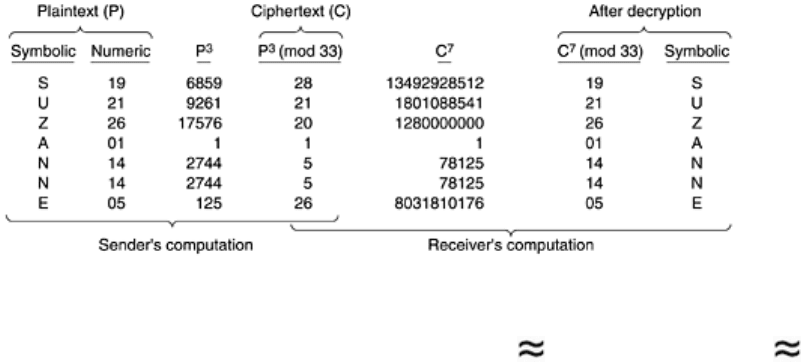
Because the primes chosen for this example are so small,
P must be less than 33, so each
plaintext block can contain only a single character. The result is a monoalphabetic substitution
cipher, not very impressive. If instead we had chosen
p and q 2
512
, we would have n
2
1024
, so each block could be up to 1024 bits or 128 eight-bit characters, versus 8 characters
for DES and 16 characters for AES.
It should be pointed out that using RSA as we have described is similar to using a symmetric
algorithm in ECB mode—the same input block gives the same output block. Therefore, some
form of chaining is needed for data encryption. However, in practice, most RSA-based systems
use public-key cryptography primarily for distributing one-time session keys for use with some
symmetric-key algorithm such as AES or triple DES. RSA is too slow for actually encrypting
large volumes of data but is widely used for key distribution.
8.3.2 Other Public-Key Algorithms
Although RSA is widely used, it is by no means the only public-key algorithm known. The first
public-key algorithm was the knapsack algorithm (Merkle and Hellman, 1978). The idea here is
that someone owns a large number of objects, each with a different weight. The owner
encodes the message by secretly selecting a subset of the objects and placing them in the
knapsack. The total weight of the objects in the knapsack is made public, as is the list of all
possible objects. The list of objects in the knapsack is kept secret. With certain additional
restrictions, the problem of figuring out a possible list of objects with the given weight was
thought to be computationally infeasible and formed the basis of the public-key algorithm.
The algorithm's inventor, Ralph Merkle, was quite sure that this algorithm could not be broken,
so he offered a $100 reward to anyone who could break it. Adi Shamir (the ''S'' in RSA)
promptly broke it and collected the reward. Undeterred, Merkle strengthened the algorithm
and offered a $1000 reward to anyone who could break the new one. Ronald Rivest (the ''R'' in
RSA) promptly broke the new one and collected the reward. Merkle did not dare offer $10,000
for the next version, so ''A'' (Leonard Adleman) was out of luck. Nevertheless, the knapsack
algorithm is not considered secure and is not used in practice any more.
Other public-key schemes are based on the difficulty of computing discrete logarithms.
Algorithms that use this principle have been invented by El Gamal (1985) and Schnorr (1991).
A few other schemes exist, such as those based on elliptic curves (Menezes and Vanstone,
1993), but the two major categories are those based on the difficulty of factoring large
numbers and computing discrete logarithms modulo a large prime. These problems are
thought to be genuinely difficult to solve—mathematicians have been working on them for
many years without any great break-throughs.
583
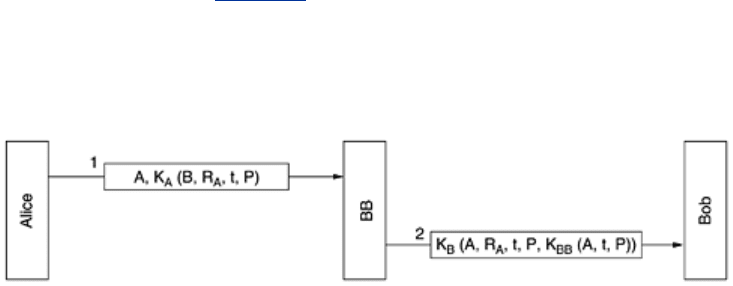
8.4 Digital Signatures
The authenticity of many legal, financial, and other documents is determined by the presence
or absence of an authorized handwritten signature. And photocopies do not count. For
computerized message systems to replace the physical transport of paper and ink documents,
a method must be found to allow documents to be signed in an unforgeable way.
The problem of devising a replacement for handwritten signatures is a difficult one. Basically,
what is needed is a system by which one party can send a signed message to another party in
such a way that the following conditions hold:
1. The receiver can verify the claimed identity of the sender.
2. The sender cannot later repudiate the contents of the message.
3. The receiver cannot possibly have concocted the message himself.
The first requirement is needed, for example, in financial systems. When a customer's
computer orders a bank's computer to buy a ton of gold, the bank's computer needs to be able
to make sure that the computer giving the order really belongs to the company whose account
is to be debited. In other words, the bank has to authenticate the customer (and the customer
has to authenticate the bank).
The second requirement is needed to protect the bank against fraud. Suppose that the bank
buys the ton of gold, and immediately thereafter the price of gold drops sharply. A dishonest
customer might sue the bank, claiming that he never issued any order to buy gold. When the
bank produces the message in court, the customer denies having sent it. The property that no
party to a contract can later deny having signed it is called
nonrepudiation. The digital
signature schemes that we will now study help provide it.
The third requirement is needed to protect the customer in the event that the price of gold
shoots up and the bank tries to construct a signed message in which the customer asked for
one bar of gold instead of one ton. In this fraud scenario, the bank just keeps the rest of the
gold for itself.
8.4.1 Symmetric-Key Signatures
One approach to digital signatures is to have a central authority that knows everything and
whom everyone trusts, say Big Brother (
BB). Each user then chooses a secret key and carries
it by hand to
BB's office. Thus, only Alice and BB know Alice's secret key, K
A
, and so on.
When Alice wants to send a signed plaintext message,
P, to her banker, Bob, she generates
K
A
(B, R
A
, t, P), where B is Bob's identity, R
A
is a random number chosen by Alice, t is a
timestamp to ensure freshness, and
K
A
(B, R
A
, t, P) is the message encrypted with her key, K
A
.
Then she sends it as depicted in
Fig. 8-18. BB sees that the message is from Alice, decrypts it,
and sends a message to Bob as shown. The message to Bob contains the plaintext of Alice's
message and also the signed message
K
BB
(A, t, P). Bob now carries out Alice's request.
Figure 8-18. Digital signatures with Big Brother.
584
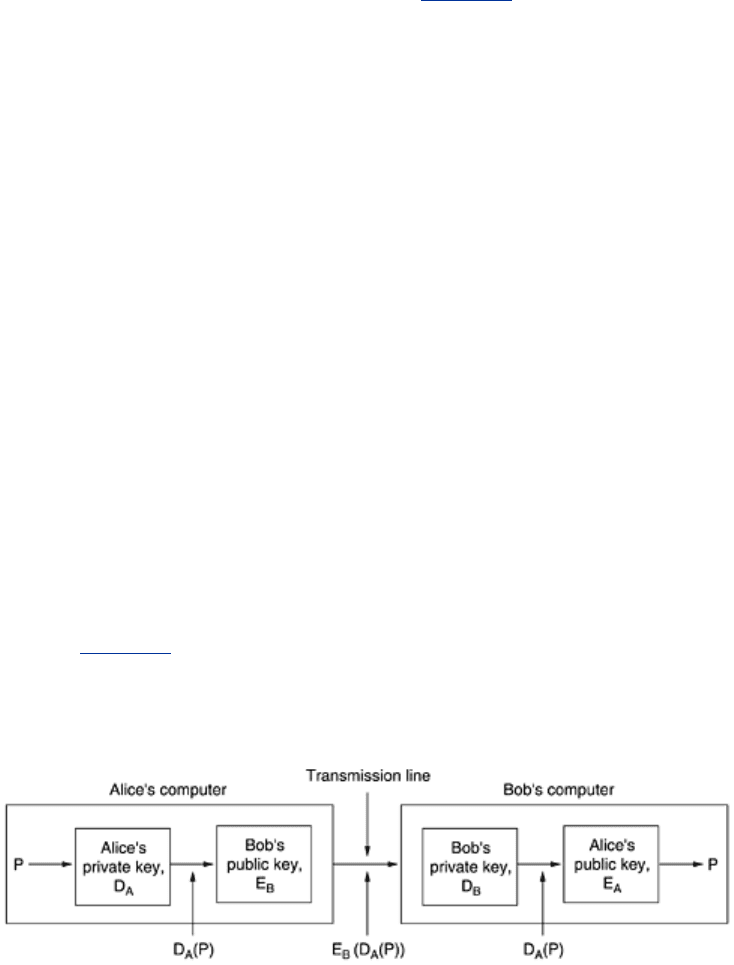
What happens if Alice later denies sending the message? Step 1 is that everyone sues
everyone (at least, in the United States). Finally, when the case comes to court and Alice
vigorously denies sending Bob the disputed message, the judge will ask Bob how he can be
sure that the disputed message came from Alice and not from Trudy. Bob first points out that
BB will not accept a message from Alice unless it is encrypted with K
A
, so there is no possibility
of Trudy sending
BB a false message from Alice without BB detecting it immediately.
Bob then dramatically produces Exhibit A:
K
BB
(A, t, P). Bob says that this is a message signed
by
BB which proves Alice sent P to Bob. The judge then asks BB (whom everyone trusts) to
decrypt Exhibit A. When
BB testifies that Bob is telling the truth, the judge decides in favor of
Bob. Case dismissed.
One potential problem with the signature protocol of
Fig. 8-18 is Trudy replaying either
message. To minimize this problem, timestamps are used throughout. Furthermore, Bob can
check all recent messages to see if
R
A
was used in any of them. If so, the message is discarded
as a replay. Note that based on the timestamp, Bob will reject very old messages. To guard
against instant replay attacks, Bob just checks the
R
A
of every incoming message to see if such
a message has been received from Alice in the past hour. If not, Bob can safely assume this is
a new request.
8.4.2 Public-Key Signatures
A structural problem with using symmetric-key cryptography for digital signatures is that
everyone has to agree to trust Big Brother. Furthermore, Big Brother gets to read all signed
messages. The most logical candidates for running the Big Brother server are the government,
the banks, the accountants, and the lawyers. Unfortunately, none of these organizations
inspire total confidence in all citizens. Hence, it would be nice if signing documents did not
require a trusted authority.
Fortunately, public-key cryptography can make an important contribution in this area. Let us
assume that the public-key encryption and decryption algorithms have the property that
E(D(P)) = P in addition, of course, to the usual property that D(E(P)) = P. (RSA has this
property, so the assumption is not unreasonable.) Assuming that this is the case, Alice can
send a signed plaintext message,
P, to Bob by transmitting E
B
(D
A
(P)). Note carefully that Alice
knows her own (private) key,
D
A
, as well as Bob's public key, E
B
, so constructing this message
is something Alice can do.
When Bob receives the message, he transforms it using his private key, as usual, yielding
D
A
(P), as shown in Fig. 8-19. He stores this text in a safe place and then applies E
A
to get the
original plaintext.
Figure 8-19. Digital signatures using public-key cryptography.
To see how the signature property works, suppose that Alice subsequently denies having sent
the message
P to Bob. When the case comes up in court, Bob can produce both P and D
A
(P).
The judge can easily verify that Bob indeed has a valid message encrypted by
D
A
by simply
applying
E
A
to it. Since Bob does not know what Alice's private key is, the only way Bob could
585
have acquired a message encrypted by it is if Alice did indeed send it. While in jail for perjury
and fraud, Alice will have plenty of time to devise interesting new public-key algorithms.
Although using public-key cryptography for digital signatures is an elegant scheme, there are
problems that are related to the environment in which they operate rather than with the basic
algorithm. For one thing, Bob can prove that a message was sent by Alice only as long as
D
A
remains secret. If Alice discloses her secret key, the argument no longer holds, because
anyone could have sent the message, including Bob himself.
The problem might arise, for example, if Bob is Alice's stockbroker. Alice tells Bob to buy a
certain stock or bond. Immediately thereafter, the price drops sharply. To repudiate her
message to Bob, Alice runs to the police claiming that her home was burglarized and the PC
holding her key was stolen. Depending on the laws in her state or country, she may or may
not be legally liable, especially if she claims not to have discovered the break-in until getting
home from work, several hours later.
Another problem with the signature scheme is what happens if Alice decides to change her
key. Doing so is clearly legal, and it is probably a good idea to do so periodically. If a court
case later arises, as described above, the judge will apply the
current E
A
to D
A
(P) and discover
that it does not produce
P. Bob will look pretty stupid at this point.
In principle, any public-key algorithm can be used for digital signatures. The de facto industry
standard is the RSA algorithm. Many security products use it. However, in 1991, NIST
proposed using a variant of the El Gamal public-key algorithm for their new
Digital Signature
Standard
(DSS). El Gamal gets its security from the difficulty of computing discrete
logarithms, rather than from the difficulty of factoring large numbers.
As usual when the government tries to dictate cryptographic standards, there was an uproar.
DSS was criticized for being
1. Too secret (NSA designed the protocol for using El Gamal).
2. Too slow (10 to 40 times slower than RSA for checking signatures).
3. Too new (El Gamal had not yet been thoroughly analyzed).
4. Too insecure (fixed 512-bit key).
In a subsequent revision, the fourth point was rendered moot when keys up to 1024 bits were
allowed. Nevertheless, the first two points remain valid.
8.4.3 Message Digests
One criticism of signature methods is that they often couple two distinct functions:
authentication and secrecy. Often, authentication is needed but secrecy is not. Also, getting an
export license is often easier if the system in question provides only authentication but not
secrecy. Below we will describe an authentication scheme that does not require encrypting the
entire message.
This scheme is based on the idea of a one-way hash function that takes an arbitrarily long
piece of plaintext and from it computes a fixed-length bit string. This hash function,
MD, often
called a
message digest, has four important properties:
1. Given
P, it is easy to compute MD(P).
2. Given
MD(P), it is effectively impossible to find P.
3. Given
P no one can find P' such that MD (P') = MD(P).
4. A change to the input of even 1 bit produces a very different output.
586

To meet criterion 3, the hash should be at least 128 bits long, preferably more. To meet
criterion 4, the hash must mangle the bits very thoroughly, not unlike the symmetric-key
encryption algorithms we have seen.
Computing a message digest from a piece of plaintext is much faster than encrypting that
plaintext with a public-key algorithm, so message digests can be used to speed up digital
signature algorithms. To see how this works, consider the signature protocol of
Fig. 8-18
again. Instead of signing
P with K
BB
(A, t, P), BB now computes the message digest by
applying
MD to P, yielding MD(P). BB then encloses K
BB
(A, t, MD(P)) as the fifth item in the list
encrypted with
K
B
that is sent to Bob, instead of K
BB
(A, t, P).
If a dispute arises, Bob can produce both
P and K
BB
(A, t, MD(P)). After Big Brother has
decrypted it for the judge, Bob has
MD(P), which is guaranteed to be genuine, and the alleged
P. However, since it is effectively impossible for Bob to find any other message that gives this
hash, the judge will easily be convinced that Bob is telling the truth. Using message digests in
this way saves both encryption time and message transport costs.
Message digests work in public-key cryptosystems, too, as shown in
Fig. 8-20. Here, Alice first
computes the message digest of her plaintext. She then signs the message digest and sends
both the signed digest and the plaintext to Bob. If Trudy replaces
P underway, Bob will see this
when he computes
MD(P) himself.
Figure 8-20. Digital signatures using message digests.
MD5
A variety of message digest functions have been proposed. The most widely used ones are
MD5 (Rivest, 1992) and SHA-1 (NIST, 1993).
MD5 is the fifth in a series of message digests
designed by Ronald Rivest. It operates by mangling bits in a sufficiently complicated way that
every output bit is affected by every input bit. Very briefly, it starts out by padding the
message to a length of 448 bits (modulo 512). Then the original length of the message is
appended as a 64-bit integer to give a total input whose length is a multiple of 512 bits. The
last precomputation step is initializing a 128-bit buffer to a fixed value.
Now the computation starts. Each round takes a 512-bit block of input and mixes it thoroughly
with the 128-bit buffer. For good measure, a table constructed from the sine function is also
thrown in. The point of using a known function like the sine is not because it is more random
than a random number generator, but to avoid any suspicion that the designer built in a clever
back door through which only he can enter. Remember that IBM's refusal to disclose the
principles behind the design of the S-boxes in DES led to a great deal of speculation about
back doors. Rivest wanted to avoid this suspicion. Four rounds are performed per input block.
This process continues until all the input blocks have been consumed. The contents of the 128-
bit buffer form the message digest.
MD5 has been around for over a decade now, and many people have attacked it. Some
vulnerabilities have been found, but certain internal steps prevent it from being broken.
However, if the remaining barriers within MD5 fall, it may eventually fail. Nevertheless, at the
time of this writing, it was still standing.
587
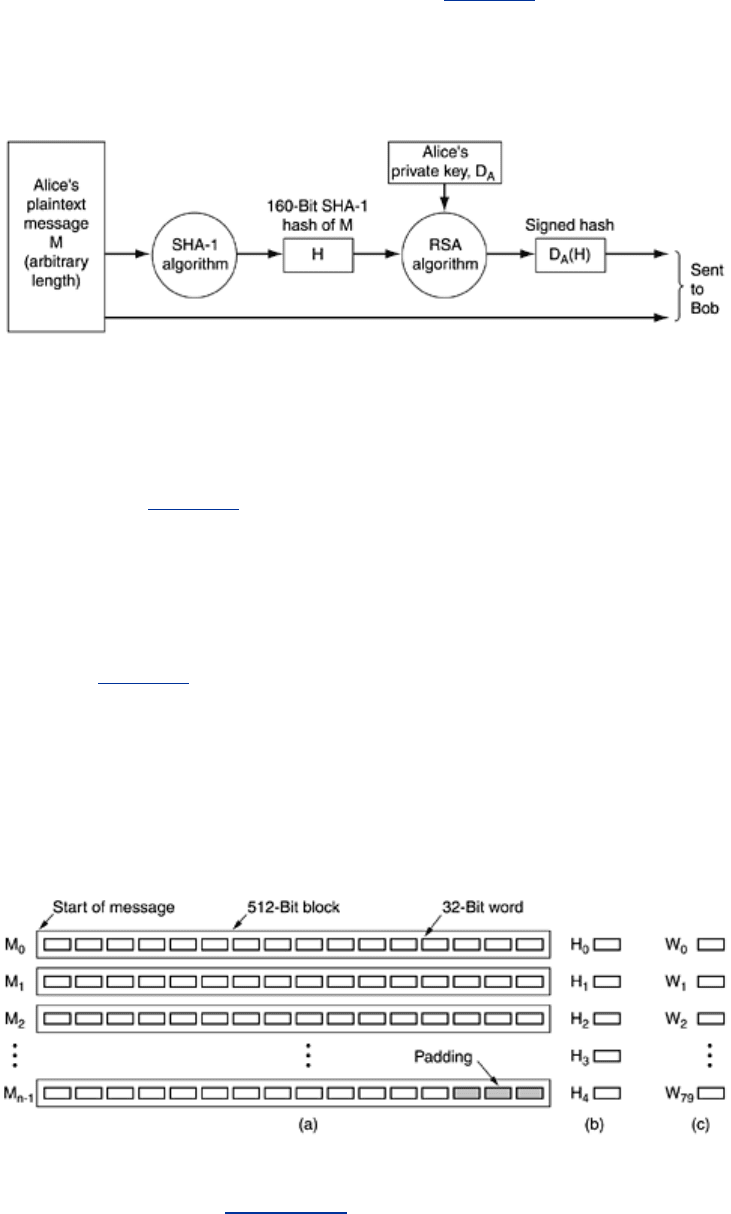
SHA-1
The other major message digest function is
SHA-1 (Secure Hash Algorithm 1), developed
by NSA and blessed by NIST in FIPS 180-1. Like MD5, SHA-1 processes input data in 512-bit
blocks, only unlike MD5, it generates a 160-bit message digest. A typical way for Alice to send
a nonsecret but signed message to Bob is illustrated in
Fig. 8-21. Here her plaintext message
is fed into the SHA-1 algorithm to get a 160-bit SHA-1 hash. Alice then signs the hash with her
RSA private key and sends both the plaintext message and the signed hash to Bob.
Figure 8-21. Use of SHA-1 and RSA for signing nonsecret messages.
After receving the message, Bob computes the SHA-1 hash himself and also applies Alice's
public key to the signed hash to get the original hash,
H. If the two agree, the message is
considered valid. Since there is no way for Trudy to modify the (plaintext) message while its is
in transit and produce a new one that hashes to
H, Bob can easily detect any changes Trudy
has made to the message. For messages whose integrity is important but whose contents are
not secret, the scheme of
Fig. 8-21 is widely used. For a relatively small cost in computation, it
guarantees that any modifications made to the plaintext message in transit can be detected
with very high probability.
Now let us briefly see how SHA-1 works. It starts out by padding the message by adding a 1
bit to the end, followed by as many 0 bits as are needed to make the length a multiple of 512
bits. Then a 64-bit number containing the message length before padding is ORed into the
low-order 64 bits. In
Fig. 8-22, the message is shown with padding on the right because
English text and figures go from left to right (i.e., the lower right is generally perceived as the
end of the figure). With computers, this orientation corresponds to big-endian machines such
as the SPARC, but SHA-1 always pads the end of the message, no matter which endian
machine is used.
Figure 8-22. (a) A message padded out to a multiple of 512 bits. (b)
The output variables. (c) The word array.
During the computation, SHA-1 maintains five 32-bit variables,
H
0
through H
4
, where the hash
accumulates. These are shown in
Fig. 8-22(b). They are initialized to constants specified in the
standard.
588
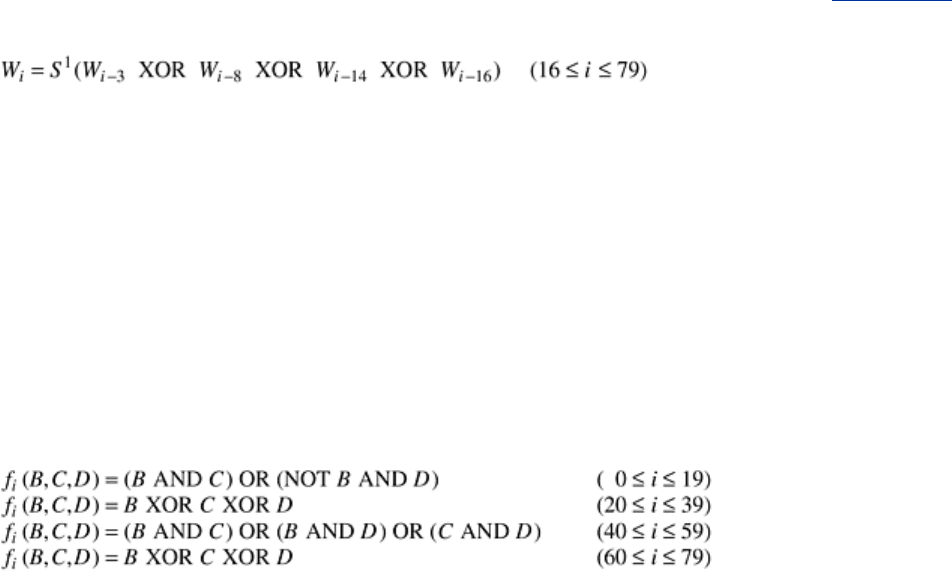
Each of the blocks M
0
through M
n
-1
is now processed in turn. For the current block, the 16
words are first copied into the start of an auxiliary 80-word array,
W, as shown in Fig. 8-22(c).
Then the other 64 words in
W are filled in using the formula
where S
b
(W) represents the left circular rotation of the 32-bit word, W, by b bits. Now five
scratch variables,
A through E are initialized from H
0
through H
4
, respectively.
The actual calculation can be expressed in pseudo-C as
for (i = 0; i < 80; i++) {
temp = S
5
(A) + f
i
(B, C, D) + E + W
i
+K
i
;
E=D; D=C; C=S
30
(B); B = A; A = temp;
}
where the
K
i
constants are defined in the standard. The mixing functions f
i
are defined as
When all 80 iterations of the loop are completed, A through E are added to H
0
through H
4
,
respectively.
Now that the first 512-bit block has been processed, the next one is started. The
W array is
reinitialized from the new block, but
H is left as it was. When this block is finished, the next
one is started, and so on, until all the 512-bit message blocks have been tossed into the soup.
When the last block has been finished, the five 32-bit words in the
H array are output as the
160-bit cryptographic hash. The complete C code for SHA-1 is given in RFC 3174.
New versions of SHA-1 are under development for hashes of 256, 384, and 512 bits,
respectively.
8.4.4 The Birthday Attack
In the world of crypto, nothing is ever what it seems to be. One might think that it would take
on the order of 2
m
operations to subvert an m-bit message digest. In fact, 2
m/2
operations will
often do using the
birthday attack, an approach published by Yuval (1979) in his now-classic
paper ''How to Swindle Rabin.''
The idea for this attack comes from a technique that math professors often use in their
probability courses. The question is: How many students do you need in a class before the
probability of having two people with the same birthday exceeds 1/2? Most students expect
the answer to be way over 100. In fact, probability theory says it is just 23. Without giving a
rigorous analysis, intuitively, with 23 people, we can form (23 x 22)
/2 = 253 different pairs,
each of which has a probability of 1/365 of being a hit. In this light, it is not really so
surprising any more.
589

More generally, if there is some mapping between inputs and outputs with n inputs (people,
messages, etc.) and
k possible outputs (birthdays, message digests, etc.), there are n(n - 1)/2
input pairs. If
n(n - 1)/2 >k, the chance of having at least one match is pretty good. Thus,
approximately, a match is likely for
. This result means that a 64-bit message digest
can probably be broken by generating about 2
32
messages and looking for two with the same
message digest.
Let us look at a practical example. The Department of Computer Science at State University
has one position for a tenured faculty member and two candidates, Tom and Dick. Tom was
hired two years before Dick, so he goes up for review first. If he gets it, Dick is out of luck.
Tom knows that the department chairperson, Marilyn, thinks highly of his work, so he asks her
to write him a letter of recommendation to the Dean, who will decide on Tom's case. Once
sent, all letters become confidential.
Marilyn tells her secretary, Ellen, to write the Dean a letter, outlining what she wants in it.
When it is ready, Marilyn will review it, compute and sign the 64-bit digest, and send it to the
Dean. Ellen can send the letter later by e-mail.
Unfortunately for Tom, Ellen is romantically involved with Dick and would like to do Tom in, so
she writes the letter below with the 32 bracketed options.
Dear Dean Smith,
This [
letter | message] is to give my [honest | frank] opinion of Prof. Tom Wilson, who is [a
candidate | up
] for tenure [now | this year]. I have [known | worked with] Prof. Wilson for
[
about | almost] six years. He is an [outstanding | excellent] researcher of great [talent |
ability
] known [worldwide | internationally] for his [brilliant | creative] insights into [many | a
wide variety of
] [difficult | challenging] problems.
He is also a [
highly | greatly] [respected | admired] [teacher | educator]. His students give his
[
classes | courses] [rave | spectacular] reviews. He is [our | the Department's] [most popular
| best-loved
] [teacher | instructor].
[
In addition | Additionally] Prof. Wilson is a [gifted | effective] fund raiser. His [grants |
contracts
] have brought a [large | substantial] amount of money into [the | our] Department.
[
This money has | These funds have] [enabled | permitted] us to [pursue | carry out] many
[
special | important] programs, [such as | for example] your State 2000 program. Without
these funds we would [
be unable | not be able] to continue this program, which is so
[
important | essential] to both of us. I strongly urge you to grant him tenure.
Unfortunately for Tom, as soon as Ellen finishes composing and typing in this letter, she also
writes a second one:
Dear Dean Smith,
This [
letter | message] is to give my [honest | frank] opinion of Prof. Tom Wilson, who is [a
candidate
| up] for tenure [now | this year]. I have [known | worked with] Tom for [about |
almost] six years. He is a [poor | weak] researcher not well known in his [field | area]. His
research [
hardly ever | rarely] shows [insight in | understanding of] the [key | major]
problems of [
the | our] day.
Furthermore, he is not a [
respected | admired] [teacher | educator]. His students give his
[
classes | courses] [poor | bad ] reviews. He is [our | the Department's] least popular [teacher
|
instructor], known [mostly | primarily] within [the | our] Department for his [tendency |
propensity] to [ridicule | embarrass] students [foolish | imprudent] enough to ask questions in
his classes.
590
